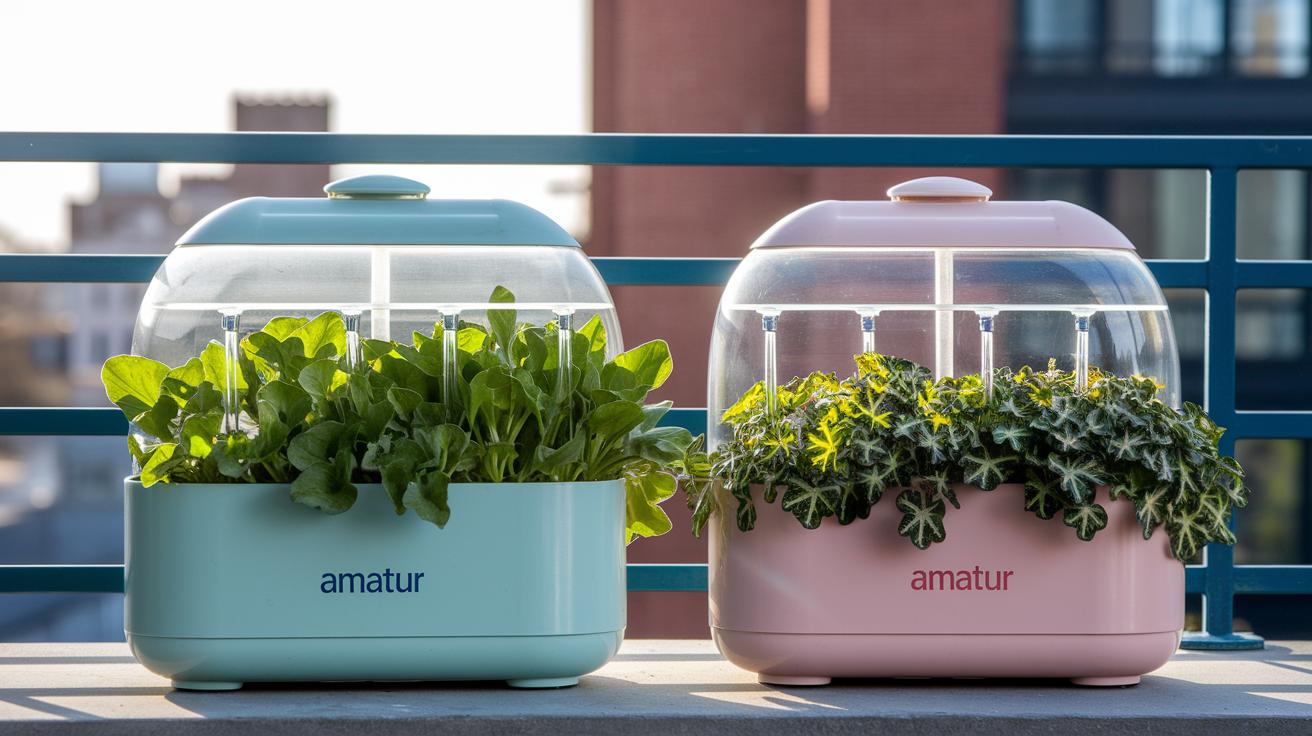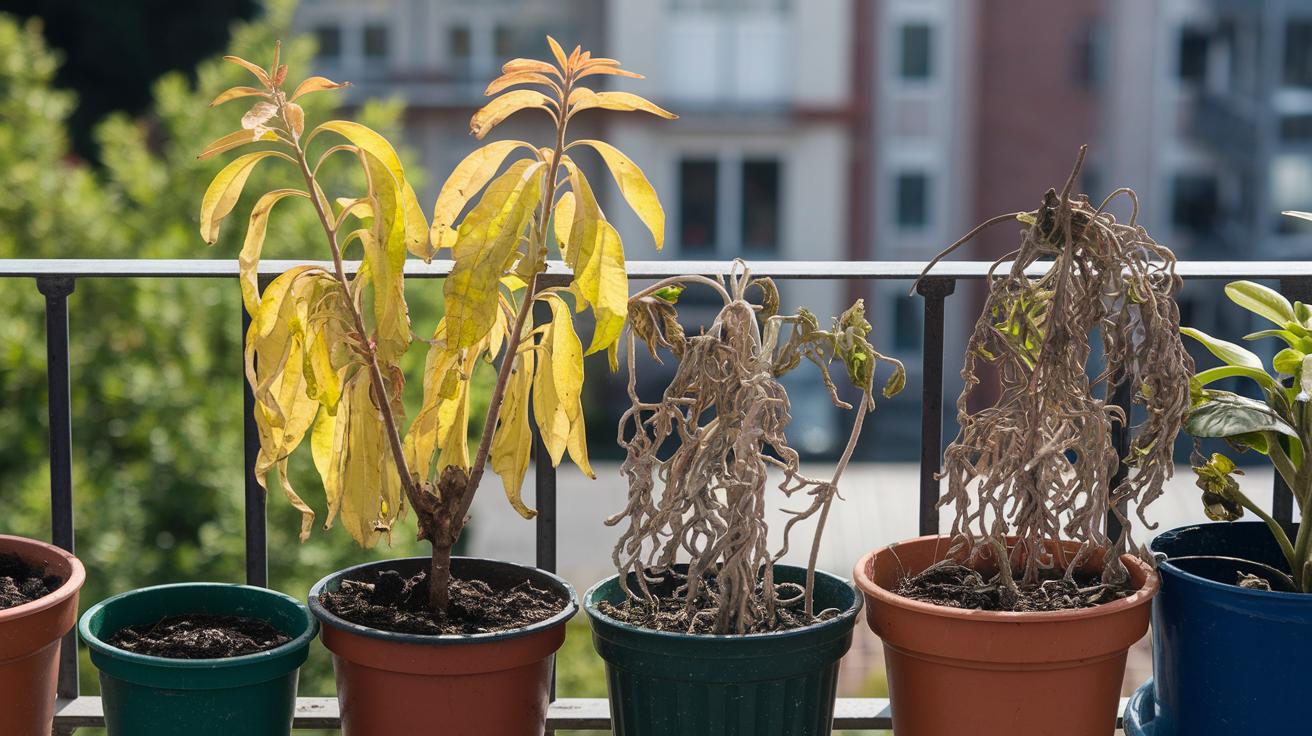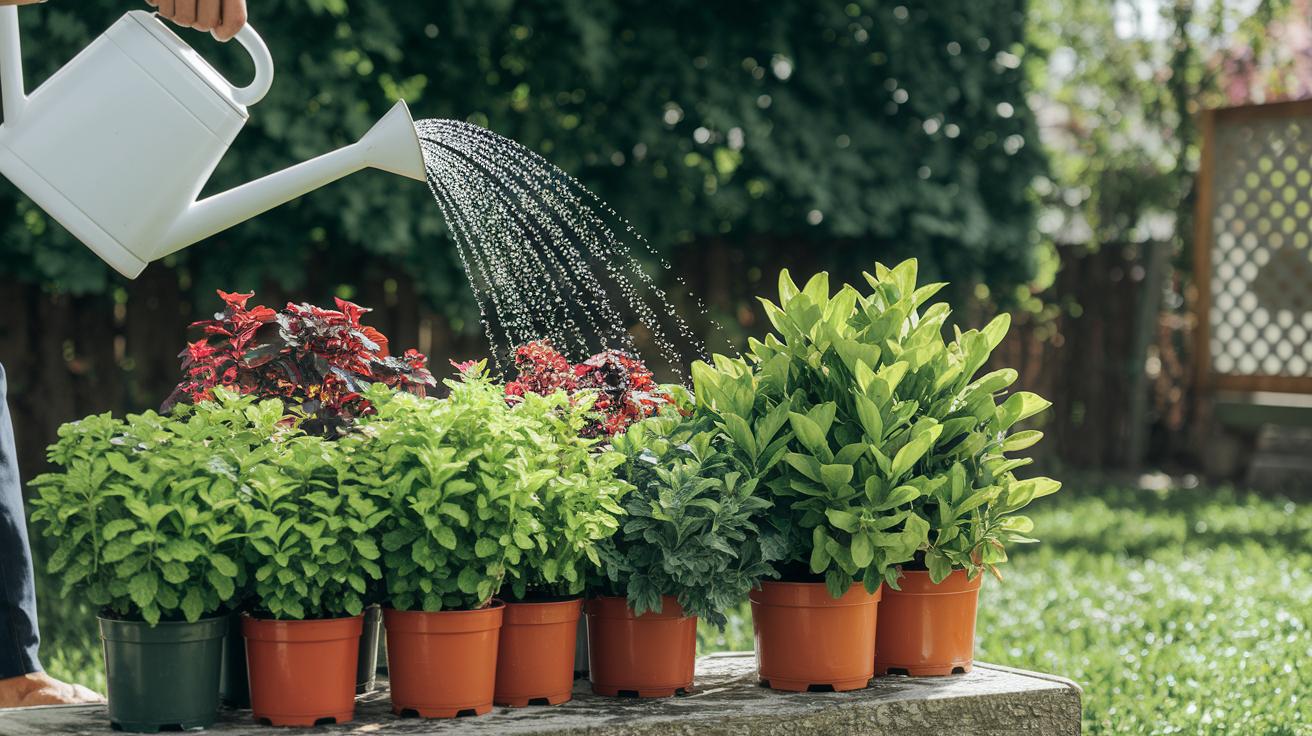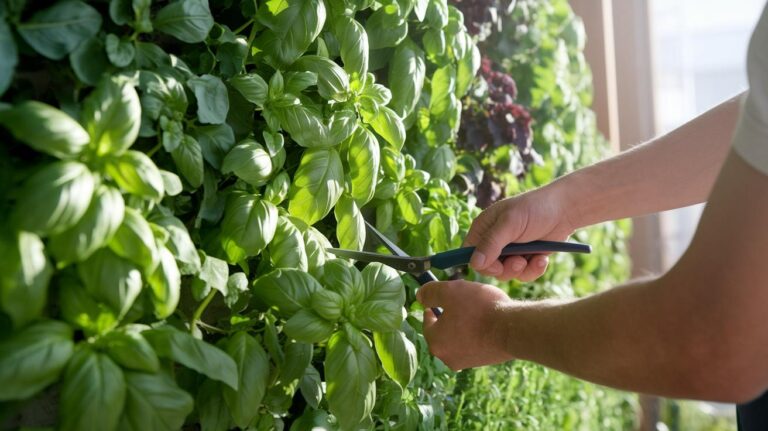Container Garden Watering Tips: Surefire Stress-Free Guide
Think watering your pots every day is a safe bet? Um, that myth can leave your seedlings (young plants) thirsty, or the roots choking in wet soil. I found out the hard way when my herbs started drooping. Oops, spilled a bit of potting soil there.
In container gardening, timing your water and matching it to each pot’s needs can save time, water, and wilted leaves. Think of your soil (the loose mix of dirt and minerals under your plants) like a sponge: moisten it, squeeze out extra, then fluff it before planting. No more guesswork.
Whether you’re on a tiny balcony or a big patio, you need to know when and how much to water. Feel the top inch of soil with your fingertip. If it’s dry, it’s watering time. Testing soil moisture (how much water soil holds) keeps basil and tomatoes happy.
This stress-free guide walks you through simple tips to water smarter and watch your container garden thrive. Ready to say goodbye to wilt and hello to lush green leaves?
Container Garden Watering Frequency and Schedule
Water your pots early in the morning or late afternoon when it’s cooler. That helps roots soak up water before the sun dries the soil. Pot size sets your watering pace. Small pots (6 inches or less) may need a drink every day. Medium pots (6 to 12 inches) usually stay damp for 2 to 3 days. Large pots (over 12 inches) can hold moisture for 3 to 4 days. Water until you see runoff (water oozing from the bottom) so the entire root ball gets wet.
By the way, my cat loves sunning on my big herb pot. Back to watering.
Summer
When the sun blazes and days stretch long, check small pots around midday. They can turn to dust fast! Give them a quick soak to keep plants happy in the heat.
Fall
As temps drop, let soil dry a bit more between drinks. You’ll spend less time watering, and plants won’t sit in soggy soil before frost.
Winter
On sunny days above 32°F, tip water sparingly so roots don’t freeze. Yep, even chillier months need a little care.
Spring
Once the soil feels warm and stays above 50°F, bump up your watering again. New leaves and flowers will thank you.
Container Garden Soil Moisture Monitoring Techniques

Want to know if your plants need a drink? Just stick a clean finger about 1 or 2 inches into the potting mix (soil blend for containers). If the layer feels dry or dusty, your plants are thirsty. The warm dirt should feel a bit damp, not crunchy.
But overhead watering can trick you. The surface might stay wet while roots down low stay parched. A quick finger check tells you if you need to add more water.
A moisture meter (tool that measures soil dampness) takes the guesswork away. Slip its slender probes into the soil and watch the readout. It’s a game changer for tiny seedlings and herbs that hate drying out.
Wow. I once watched a clay pot dry out in hours on a hot afternoon. Terra cotta pots (unglazed clay) act like a sponge, wicking water away fast. Plastic pots hang on to moisture longer.
Containers baking in full sun dry out quicker than those in shade or under a porch. Check sun-soaked pots more often, you know? When your meter reading dips below the mid mark, it’s time to water again.
Oops, forgot to mention: let extra water drain so roots don’t sit in a puddle. Back to soil checks, this simple routine keeps leaves perky and roots happy.
Container Garden Drainage and Container Selection
Have you ever had water pool at the top of a plant pot? Oops, that means soggy soil and unhappy roots. That’s why containers need plenty of drainage holes! You want those holes at the very bottom so extra water can slip out.
Think of soil like a sponge, moisten it, squeeze out extra water, then fluff it before planting. It feels soft, like warm earth crumbling between your fingers. Small pots (under 6 inches) dry out fast. Medium pots (6 to 12 inches) hold water for a day or two, and large pots (over 12 inches) stay damp longer.
Let’s talk layers. Start with a bottom layer of perlite (light volcanic glass that helps water drain). Next add expanded clay pellets (round, baked clay bits that make air pockets). Vermiculite (a soft mineral that holds a little moisture and lets roots breathe) fits right in too.
So now you’ve got quick water flow below, you know? But the top mix needs to save some moisture. Stir in coco coir (fibrous coconut husk material) or another peat-free blend. That way even small pots grip just enough water and big pots don’t turn into mud.
Matching pot size with a watering rhythm keeps roots happy.
| Container Size | Recommended Watering Frequency |
|---|---|
| Small (≤6″) | Daily |
| Medium (6–12″) | Every 2–3 days |
| Large (>12″) | Every 3–4 days |
Container Garden Drip Irrigation and Self-Watering Systems

Watering pots day after day can feel like a never-ending chore. Automating your watering lets you kick back and watch the warm sun glint off your leaves. Add a simple timer (it clicks on when you set it) and a moisture meter (tool that checks how damp soil is), and you’ll know each plant gets just the right sip.
Drip Irrigation Setup
Start by running the main tubing along your pots. Then pop in a tiny drip emitter at each root ball (the clump of roots at a plant’s base). You’ll hear a soft drip as water trickles out. If it gushes too fast, clip on a pressure regulator.
Want super low tech? Grab a clean bottle, poke a few holes in the cap, stick it into the soil, and twist to slow or speed the drip. Easy.
Self-Watering Planter Selection
Self-watering planters have a built-in reservoir under the soil. Water wicks up (like a towel soaking up a spill) and keeps roots nice and damp. You only need to refill every few days, hello, extra weekend free time.
Look for a planter with a clear fill line so you know exactly when to top it off. By the way, my cat loves napping next to mine. Cute, right?
Programming Irrigation Timers
Attach a timer to your faucet or pump. Pick cool hours, early morning or late evening, so water isn’t lost to midday heat.
Run short watering cycles and then stick your moisture meter in the soil. If it’s still bone-dry, add more time. Veggies usually need more water than succulents, so tweak each zone until your pots feel just right, moist but not soggy.
Container Garden Water Conservation and Mulching Methods
Lay down a 1–2 inch layer of organic mulch (decayed leaves and plant bits that enrich soil) like bark chips or straw. It feels warm and shields the soil from the hot sun. And it locks in moisture so you don’t need to water as often. You’ll notice cooler soil under your feet and happier leaves with less daily fuss.
Rainwater harvesting is like catching sky in a bucket. Set a few barrels or buckets under your downspout and let them fill up. Use that fresh water on dry days or save greywater (lightly used water from your laundry tub, just not on veggies) for thirsty potted plants. Group pots by how much water they need and choose drought-loving plants like lavender or sedums for fewer top-ups.
Try mixing coco coir (a fluffy fiber that holds water like a sponge) into your potting mix before you plant. It soaks up drips, keeps roots cozy between drinks, and helps the soil stay damp longer. Then watering becomes a breeze. That’s backyard savvy.
Container Garden Watering Troubleshooting and FAQs

Have you ever seen your potted plants flop over, their leaves feeling brittle like dry pasta? That’s a sign of underwatering (not enough water). You might also notice the soil pulling away from the pot’s edge or tiny stems staying stunted like they’re frozen in time. But watch out, too much water can be just as tricky. When plants sit in soggy soil, their leaves can turn yellow, the pot might smell musty from mold, and roots can rot (decay) from staying wet too long.
So how do you tell if your plants are thirsty or drowning? It’s simple: stick your finger about an inch or two into the soil. If it feels dry, go ahead and water. If it’s still damp, give your plants a break.
Fixing both too little and too much water starts with good drainage. First, check that your pots have clear holes at the bottom so extra water can run out. If you’re worried about root rot, flush the pot with fresh water until what drips out looks clear, then let it drain completely. Next, feed gently, mix liquid fertilizer at half strength so you don’t burn those sensitive roots or pile up salts in the soil.
Now comes the fun part, tuning into your container garden like it’s its own little weather station. Notice how a pot baking in full sun drinks twice as fast as one lounging in dappled shade. Pay attention to how quickly the topsoil dries on a hot afternoon. With this hands-on “feel the soil” approach and a bit of trial and error, you’ll find the perfect watering rhythm. Before you know it, every leaf will look perky and you’ll feel like a true backyard superstar.
Final Words
You’ve nailed a simple watering schedule from small pots to large containers, with early-morning or late-afternoon routines.
You learned to check moisture by feel or meter, choose the right pots and drainage layers, and set up drip or self-watering systems.
You added mulch, saved water, and tackled overwatering or dry spells with quick fixes.
Now your garden’s ready to thrive with these container garden watering tips. Enjoy every lush, low-effort moment in your backyard!
FAQ
How often should I water my container garden based on pot size?
Container garden watering frequency depends on pot size: small pots (≤6″) need water daily, medium (6–12″) every 2–3 days, and large (>12″) every 3–4 days to keep roots moist.
Why is morning or late‐afternoon the best time to water containers?
Morning or late‐afternoon watering reduces evaporation and helps roots absorb more moisture before harsher sun or cooler night sets in.
How do seasonal changes affect container watering schedules?
Seasonal changes affect container watering: in heatwaves, water more often; as daylight shortens, water less; at frost risk, let soil dry slightly; in spring, increase for growth.
How can I check soil moisture in containers accurately?
Insert a finger 1–2 inches deep: if it feels dry, water. For precision, use moisture meters—especially for seedlings or moisture‐sensitive plants.
What container materials and features impact watering needs?
Terra cotta dries out faster via evaporation, while plastic holds moisture longer. Adequate drainage holes prevent waterlogging and root rot.
How do I set up drip irrigation or self‐watering systems for containers?
Install micro‐emitters or wick reservoirs with timers to deliver steady moisture, save effort, and cut waste—tailored to each plant’s needs.
What are simple ways to conserve water in container gardens?
Use a 1–2″ mulch layer to curb evaporation, group plants by need, collect rainwater, reuse greywater safely, and mix in water‐retentive soils like coco coir.
How can I tell if my container plants are overwatered or underwatered?
Overwatered plants show yellow leaves, moldy soil, or root rot. Underwatered plants have wilting, brittle leaves, or stunted growth. Adjust watering based on these signs.







